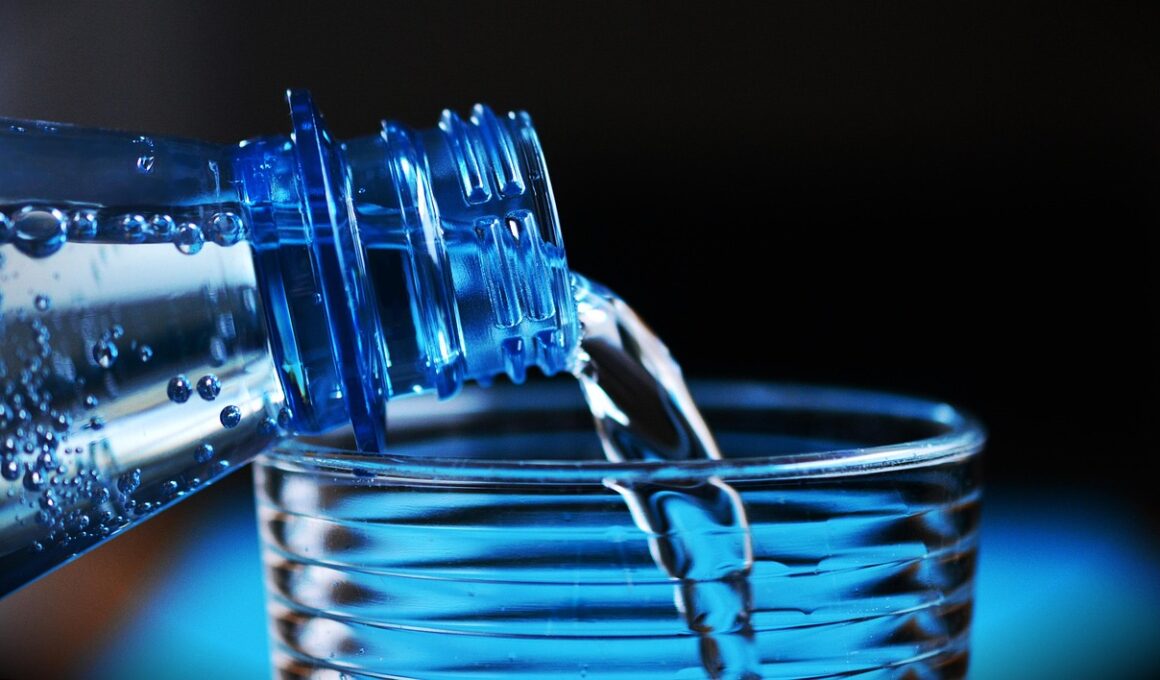Tracking Hydration: Mobile Apps and Tools for Runners
Staying hydrated while running is crucial for overall performance and recovery. Dehydration can lead to fatigue, decreased endurance, and even severe health risks. This is where mobile apps and tools come into play. Running applications now offer various features specifically designed to track and manage hydration. These tools can integrate seamlessly with physical activity metrics, providing real-time hydration data. Some apps can be customized to account for individual sweat rates, temperature, and duration of exercise, allowing for personalized hydration strategies. Moreover, some sophisticated applications even send reminders to drink water at set intervals or after certain distances have been covered. By utilizing these digital tools effectively, runners can ensure that they meet their hydration needs. With wearable technology and smartwatches, users can monitor their hydration levels alongside their heart rate, pace, and distance. Achieving the right balance of hydration is vital, especially for those training for long-distance events. Therefore, taking advantage of these technologies can significantly enhance athletic performance and longevity in running. Regular assessments of hydration can prevent issues that arise from neglecting this critical aspect of training.
Popular Hydration Tracking Apps
There are several well-known apps designed specifically for tracking hydration among runners. One of the most popular amongst athletes is Garmin Connect. This app syncs with Garmin wearables to provide hydration tracking, helping runners monitor their fluid intake accurately. Strava is another versatile platform that not only tracks your runs but can also remind you to hydrate appropriately. MyFitnessPal excels at tracking nutritional intake, including water consumption, allowing you to link your hydration habits to your overall diet. Hydration Aide is explicitly focused on fluid intake, making it simple to log every glass of water throughout the day. These apps can also help users set daily hydration goals and analyze trends in their data. Additionally, many of these platforms allow sharing with friends or joining teams, enhancing motivation through accountability. Finally, once you’ve logged your hydration stats, the analytics provide insights into your habits. These analytics can help you identify patterns regarding when you are most likely to forget about hydration, prompting you to take preemptive action. This comprehensive tracking fosters better habits and performance.
Beyond mobile apps, various wearable devices offer hydration tracking capabilities. Smartwatches, fitness trackers, and even specialized hydration sensors provide continuous measurement of hydration levels. For instance, some advanced fitness trackers have built-in sensors that estimate sweat rates during workouts. These measurements help runners adjust their hydration plans accordingly. Some devices even integrate with hydration-specific apps, providing a centralized platform to manage all metrics. Smart bottles like the HidrateSpark come equipped with sensors that track the amount of water consumed, syncing data with associated apps for easy monitoring. These innovations bring further engagement to maintaining hydration. Ensuring that every sip is tallied avoids the common pitfalls of underestimating fluid needs. Moreover, with emerging technologies, the future of hydration tracking looks promising. Runners can expect even more accurate assessments of hydration through innovative sensors. This technology will likely blend seamlessly with existing fitness ecosystems, providing insights that evolve based on individual sweat profiles, exercise intensity, and climatic conditions. In the quest for peak performance, integrating these devices is becoming increasingly essential for serious runners.
Setting Personal Hydration Goals
When using mobile apps and tools to track hydration, it is essential to set personal hydration goals. These objectives shouldn’t just be generic but must align with your specific requirements as a runner. Identifying factors such as body weight, climate, workout intensity, and duration can guide you in establishing a sensible hydration plan. Apps like MyHydrate yield personal hydration recommendations based on intimate physiological data. Additionally, commencement of any new training program should include an assessment of hydration needs. Calorically dense runs might require increased water intake, while casual jogs may only need slight adjustments. It’s about finding balance and being mindful of your body’s needs. Keep in mind, hydration isn’t just a pre-run consideration; it should be a holistic approach involving intake during exercise and recovery. Apps can prompt you to check in with your hydration several times throughout the day, creating a routine that solidifies the practice. By gradually refining your goals, you can respond better to differing conditions and physiological requirements. This personalized tracking will enhance your running performance, especially in extreme conditions.
To further enhance hydration tracking, group runs can be a vital part of your strategy. Sharing your hydration goals with fellow runners can stimulate collective commitment. App platforms often include social features where you can exchange tips and motivate each other to stay hydrated. This camaraderie can lead to a supportive running community that prioritizes hydration. Furthermore, some apps allow users to challenge each other to meet hydration goals, which introduces an element of fun and accountability. Competitions around hydration can be an effective way to instill motivation. You can even schedule hydration check-ins during running sessions to encourage awareness. Remember, engaging with friends not only checks your hydration habits, but it also creates a vibrant culture centered around health and wellness. By integrating social elements, you broaden your awareness of the importance of hydration while running, cultivating relationships that help push personal performance. This multifaceted approach can elevate your running experience, considering hydration is not solely a personal journey but can become an inclusive part of group dynamics. Such strategies ensure every run prioritizes hydration, ultimately fostering healthier outcomes.
Best Practices for Hydration While Running
Establishing best practices for hydration while running is vital to ensure that technology is effectively utilized. Firstly, always create a hydration plan before long-distance training or events. Input estimated sweat rates and weather conditions into your chosen app to clearer gauge needs. Timing of hydration is critical; drink before you feel thirsty. Moreover, it’s beneficial to consume fluids regularly throughout runs rather than chugging large amounts intermittently. Consider using electrolyte drinks for longer runs, as they help replenish lost minerals. Apps may provide insights on optimal hydration intervals customized to your pace and distance. Post-run, be diligent about hydration. Your body needs water to recover, and keeping track through apps will ensure fluid replenishment occurs. Always carry a water bottle or plan for water stations along routes. Tracking both water intake and output through specialized tools can provide a comprehensive view of hydration. Monitor urine color as a physical indicator, with a lighter shade representing adequate hydration. Regular adjustments based on activity levels and environmental factors are essential to solidifying effective hydration strategies, ensuring you stay physically prepared and healthy.
Consistency in hydration tracking will yield the best outcomes for runners. Use your preferred mobile app to maintain a continuous log of your fluid intake and adjust as necessary. You can develop routines around your hydration practices, such as measuring water intake at specific times of the day. Consider evaluating your hydration metrics weekly within the app to establish practices that work best for your lifestyle. Evaluating how you felt during runs or workouts in correlation with hydration levels in your app can provide valuable insights. Keep open communication with coaches or trainers who can advise personalized hydration plans. The beauty of technology is that it evolves; stay updated on any new features that app developers introduce. These improvements may refine your hydration tracking experience and provide enhanced ways to monitor well-being. Research indicates that properly managed hydration positively affects overall fitness levels. Thus, ensuring that your approach to hydration combines all these elements becomes crucial for successful training. Ultimately, leveraging mobile apps and wearable technologies effectively can redefine your mindset towards hydration as a fundamental part of running and overall athletic performance.
To conclude, integrating mobile apps and technologies for tracking hydration can significantly offset challenges runners face regarding hydration management. As athletes become more aware of their bodies’ needs, the necessity of strategic hydration grows. Effective tracking tools simplify the process, making it easy to log water intake and receive timely reminders. As a result, these applications offer the potential for improved performance, recovery, and overall health. Utilizing group challenges and competitions adds a fun dimension to hydration tracking. Therefore, community support developed through shared goals and actions can be an excellent motivator. The advances in wearable technology further enhance hydration awareness, helping runners access real-time data that influences their hydration strategies. Prioritizing a personalized hydration plan through these digital resources ultimately promotes better running experiences. Make it a habit to regularly review hydration goals, and don’t hesitate to make adjustments based on performance feedback. Building these practices into your training ensures hydration becomes second nature rather than an afterthought. As runners continue to innovate within their routines, embracing these tools will undoubtedly yield beneficial results for health and athleticism, making the pursuit of running an even more enjoyable and rewarding endeavor.


